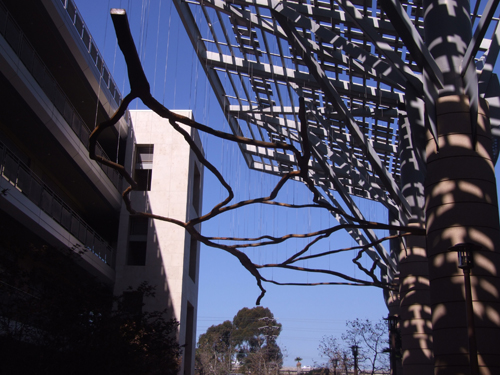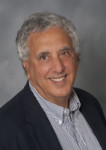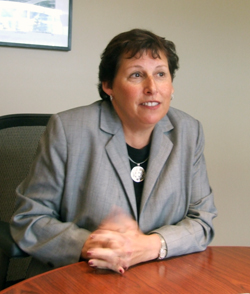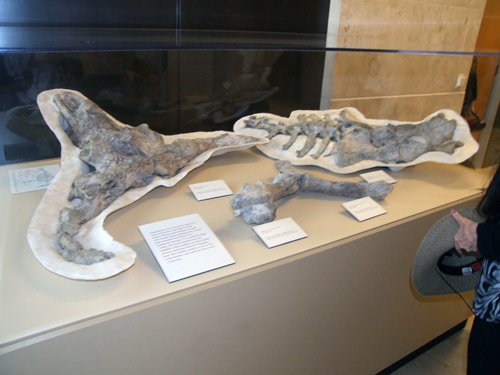
By Donald H. Harrison


SAN DIEGO—While Laurie Berman was growing up as one of the few Jewish girls in her small Michigan city, her parents urged her to become a doctor. However, volunteering during her high school years at a local hospital, she realized that she didn’t like the sight of blood and decided to look for some other kind of career. Now, ironically, she is in charge of the construction and maintenance of arteries and the improvement of circulatory systems. Transportation arteries, that is, as in freeways and highways.
Berman is District 11 director for the California Department of Transportation, also known as CalTrans. Her area of responsibility includes San Diego and Imperial Counties, both bordering Mexico, and her offices are in the Wadie P. Deddeh State Office Building in Old Town San Diego. Deddeh, a pioneer of San Diego County’s large Chaldean community, was a legislator who helped delineate CalTrans’s responsibilities. A sculpture of San Diego County’s major freeway system—what might be called Berman’s realm–is suspended above the courtyard of the office complex.
In an interview with San Diego Jewish World, Berman spoke about her Jewish background, her career path, and some of the CalTrans projects, success stories and challenges occupying her attention.
Born Laurie Steinborn, the CalTrans director said she “grew up in a city with a very small Jewish population – East Lansing. There were one or two other Jewish kids in my elementary school classes and, during this time of year (December), we always had to explain that ‘we don’t celebrate Christmas,’ and nobody got that.” This was quite a change for her mother, who had grown up in Chicago, where her own school closed down for lack of students during the Jewish High Holy Days. “That’s one of the things I like about San Diego, the diversity here. Everybody has a story and everyone has a different story,” Berman said.
For five summers in a row, Berman attended two-month sessions at Camp Ramah in Utterson, Ontario, where she learned much about Judaism and Jewish identity. The camp is affiliated with the Conservative Jewish movement. Her parents helped to start a small congregation in East Lansing, Kehillat Israel, which, according to Berman, started in the Conservative movement but today is more Reconstructionist.
At Michigan State University, Berman found that she enjoyed engineering, a field she described as “figuring out what makes all those things work and how to make things better.” Eventually, she focused on transportation engineering, and right out of college, with husband Jeff, she moved in 1983 to California to take a position in the bridge-building department of CalTrans. She describes that job, and the several CalTrans positions she has held since, as opportunities to “impact people’s lives every day by making sure they can get where they need to go and safely, and hopefully in a routine way.”
While the Bermans have not affiliated with any congregation in San Diego, she said they do attend events sponsored by the Jewish Federation of San Diego County from time to time.
Berman tells of the pride she takes in transportation projects that improve the environment, projects the Jewish community might cite as examples of “tikkun olam” or repair of the world. For example, there is a works program in which CalTrans is partnering with the San Diego Association of Governments (SANDAG) that is called the “Interstate 5 North Corridor Project.”
“It is a showcase of what our projects of the future will be,” Berman said. “It is not just a freeway widening. We are adding lanes for HOV (high occupancy vehicles) and transit and we are building better access to the coastline for bicyclists and pedestrians.”
“In the 1970s,” she added, “we built bridges as short as we could to save money, but that impacted the health of the lagoons, which in the ‘70’s we were not thinking about. So we are going to replace some of the lagoon bridges to improve the tidal flow between the ocean and the lagoon. It’s a project that will improve the environment.”

Berman became district director in 2009 and a few years afterwards, CalTrans construction crews on California Highway 76 uncovered some bones that created quite a stir among paleontology enthusiasts at the Natural History Museum in Balboa Park. They turned out to be the fossilized remains of a prehistoric bison, estimated to have lived sometime between 100,000 and 200,000 years ago. What made the find so exciting was that bison—commonplace in the northern plains of the United States—were not known before to have grazed as far south as San Diego County.
Whenever CalTrans does a major dig, an archaeologist is assigned as a monitor, just in case something new is found in the diggings. Today, the bison bones are on exhibit in the lobby of the Deddeh Office Complex.
As cars become more and more energy efficient, it’s both good and bad news for the CalTrans district director. She explained: “A lot of our funding is from the gas tax, which is a per gallon tax, not a percentage tax, so as cars become more efficient it is really good, but it is less and less money for us.” To find a substitute method of financing California’s transportation system, “there is a pilot program that the Legislature just passed and the governor signed to look at a road-user charge, which a lot of other states also are looking at. The other place where we get our funding is the TransNet sales tax and without that you would see far fewer projects in San Diego.”
If a road-user charge were enacted, she added, “the basic concept is that we would find out how much you drive, or you report it, and there’d be a fee per mile. If you don’t drive a lot, you don’t pay much, but if you are using an energy-efficient vehicle you still have to pay. You are using the road, so you have to pay.”
The mechanics of such a program are still under study, Berman said, but unless some way to provide CalTrans with more revenue is found, needed construction projects and various types of maintenance might have to be put on hold.
In the meantime, she said, another important capital project, in cooperation with local authorities, the federal government, and Mexico is the construction of another border crossing east of Ota Mesa.
SANDAG will serve as the tolling agency on a new road that will feed trucks directly to and from the border crossing. “If you ever go down to the border and see the line of trucks waiting to come across, it is really impacting San Diego’s economy,” Berman said.
Asked if such an international project should be funded by the federal government, the CalTrans director responded, “Well, that is the standard model and we would have to wait for the federal government to provide the capital. However, the federal government just funded the San Ysidro (border crossing) modernization, which is really nice and makes a difference, but it takes a long time to get funding for these projects. I think the folks in San Diego realize we can expedite these things by doing them for ourselves.”
Berman oversees 1,200 CalTrans employees, who work in various fields such as planning, construction and maintenance in the two-county area, which boasts over 1,000 centerline miles of highway. Although maintenance doesn’t attract the kind of attention from the public as new construction, it is a critical part of the work CalTrans does.
“For me and my district it is really important that we are keeping our drains clear, that we are fixing the potholes, and doing those things that if left unattended will destroy the system,” Berman said. “We also spend a lot of time and money picking up trash and maintaining our landscaping. We are in the process now of converting our sprinklers to smart controllers, so that when it is raining they turn themselves off and we don’t have to have people go around to turn them off.
“I have the same staff that we had 10 years ago and our system keeps expanding, so trying to stay on top of the weeds that need to be cleared, the litter picked up, and the potholes filled so you don’t have sinkholes, are examples of work that need to go on every day.”
Berman made a plea to all motorists: “If people would quit littering and tie down the loads on their cars, that would help us a lot.”
Additionally, she mentioned the “Adopt-A-Highway” program in which citizens and businesses can take responsibility for keeping a stretch of highway clean. Individuals or organizations may undergo training to do highway clean-up, or they can hire state-approved vendors. Such sponsorship is acknowledged with signs on the affected stretches of highway.
Furthermore, said Berman,“we are looking at whether businesses would be interested in adopting a section of trees, and maybe we could trim the palm trees more often. If people have other thoughts about what they would like to adopt, we are open to listening to them. I want to say how much we appreciate the volunteers who come out. We get a lot of calls from people who say ‘you need to come out here and pick this up’ and it’s nice to get a call every now and then from people who want to be part of cleaning up our community.” More information about this program may be obtained from CalTrans at (619) 688-6670 or via its website at www.dot,ca.gov/dist11.
A fairly recent project that occurred on Berman’s watch was the painting of highway shields on the surface of west bound lanes on Interstate 8 on the approach to Interstate 5.
Berman credited Mark Phelan, a senior transportation surveyor, with bringing the idea to CalTrans after he took a family trip in his car and noticed similar freeway shields painted near a busy junction in Louisiana. “We wanted to try it because we had a lot of collisions in that area (Westbound I-8 through Hotel Circle) as people tried to figure out where they were supposed to be. There are a lot of tourists going from Hotel Circle to the beach, and this is a low cost method to help tourists get around. So we thought we would try out the shields there and see if the idea holds up over time and whether it has the intended consequences of minimizing crashes.”
If the project works, she said, shields may be placed on other highway roadways in San Diego County—perhaps on Highway 163 as it approaches downtown from Mission Valley, and “other places where it is hard for drivers to line themselves up.”
As our interview drew to a close, I thought how interesting it is—perhaps uniquely so—how many Jewish women in San Diego County currently occupy the top executive spots in major public organizations. Besides Berman, those that come immediately to mind are District Attorney Bonnie Dumanis, San Diego School Superintendent Cindy Marten, and San Diego Police Chief Shelley Zimmerman.
*
Harrison is editor of San Diego Jewish World. Comments on this article may be posted in the space provided below or the author may be contacted directly via donald.harrison@sdjewishworld.com